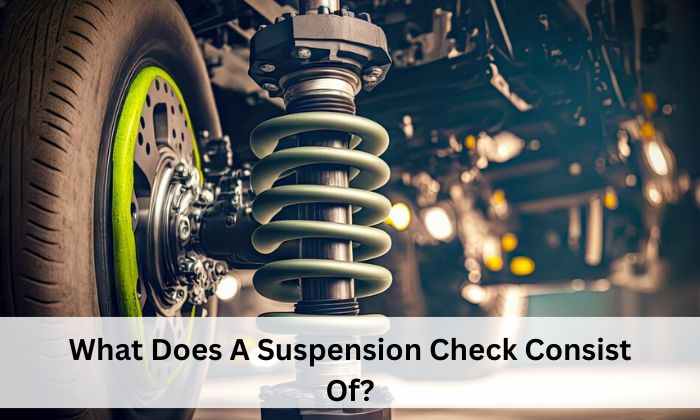At some point, you’ll notice that your car isn’t running or feeling the same as it did before. You can sense the vehicle moving to the right as you countersteer more. This is one of the signs that your ban might need to be changed. We’ll show you how to check your car’s suspension and outline the five necessary signs to fix it.
| Step | Description |
| Visually inspect strut mounts | Check for corrosion, rust, and damage. |
| Measure front wheel heights | Assess height difference between sides. |
| Jack up the car | Locate designated jack points carefully. |
| Look for damage or grease | Inspect rubber bushings and components. |
| Check tie rod ends | Inspect connection between steering box and wheels. |
5 Steps To Check Car Suspension
Visually Inspect Strut Mounts
You don’t have to jack up the car for this step. Opening your car’s hood lets you see each side’s strut or shock towers. These towers generally go through the fender just above each wheel and are held in place by bolts and nuts. Keep an eye out for rust or rusting on the screws that go over and aren’t broken or loose in any other way.
Measure Front Wheel Height
Find the distance with a tape measure between the top of the tire and the bottom of the fender on the driver’s side of the car.
If there is a change in height, do this step again on both passenger sides. It’s okay if you see a slight difference (2.5 cm or less); the two should be the same.
A lot of the time, the problem starts with one side being lower than the other. Even if they are pretty even, there could still be a problem with the delay that makes both sides feel bad, which brings us to step 3.
Jack Up The Car
You’ll need to get the trusty jack out before you can get under your car to look more closely. Before you try to lift the vehicle, make sure you read the owner’s instructions to find the jack spots. If you attempt to jack up the car from anywhere, you could damage it badly and also put yourself in danger.
Check For Damage Or Grease
A flashlight might help you see what’s under the car if you’re having trouble. Check the rubber joints on each wheel one at a time. This part helps keep the metal parts of the frame from touching each other. When they’re not being used, they can turn gray over time. They are usually black.
Keep an eye out for any cracks or tears in the bushings; this means they need to be replaced. When a rubber joint is worn out, it can’t separate the metals as it should, which makes the ride rougher and louder.
If a bushing is missing or broken, you shouldn’t drive your car longer because it won’t be able to handle shocks when going over bumps. This can put you and other drivers on the road in great danger.
Check Tie Rod Ends
There are a few more steps to this step, but we’ll walk you through them all individually. First, find the box for the power steering and follow the arms from it to the wheels. If you can’t see it, you should look in the owner’s guidebook because it’s in a different place on each make and model.
The tie rod connects the steering box and the wheels, an essential part of the chassis. If the joints are broken or worn out, the car may not handle as well and have dead spots when turning. This makes driving very dangerous because you might be unable to control your vehicle.
6 Signs Suspension Needs Replacement
Ride Is Bumpy
The first thing you’ll notice about worn-out shocks or springs is how your car drives. Every little bump in the road will feel like you’re going off-road; it will be like a “bounce.”
One-way Turn
If your car starts to slide or pull to one side while you’re going straight, that’s one of the first signs that something is wrong with the suspension. Tires that wear and pressure unevenly are often to blame. Sometimes, you may feel like you need to countersteer even when you’re not moving.
Trouble Steering
Does your turning wheel not work? Something is wrong with the suspension if the steering feels heavy, pulls to one side, or doesn’t seem to respond when you turn, especially when you’re going slowly. It could be because the steering fluid level is too low or something much worse. If this is happening to you, you should talk to a professional.
Brake-pressed Nose Dives
If the shocks are worn out, the car’s front end may “nose dive” every time you press down on the brakes hard. If this starts to happen, you should get your vehicle checked out by a mechanic right away because it could make it harder to stop quickly in an emergency. A bad suspension can add up to 20% to the time it takes to stop.
Uneven Tread
If the wear isn’t even or the tread is bald in some places, the car’s frame isn’t keeping it up evenly, which puts different amounts of pressure on the tires.
Damaged Or Greasy Shocks
There is probably a fluid leak if you see any fluid buildup or the shocks and springs look greasy. If there is a steering oil leak, your suspension is broken and needs to be changed. It is hazardous to drive around with little steering fluid.
Conclusion
Checking your car’s suspension is vital to keeping it safe to drive. You can find possible suspension problems early on by looking at the strut bolts, measuring the wheel heights, and checking the parts for damage or wear. Rides that are rough, trouble turning, and uneven tire wear are all signs that the suspension needs to be fixed. Paying quick attention to these signs can stop more damage and keep the car running at its best.
FAQs
How Often Should I Check My Car’s Suspension?
It’s a good idea to check your car’s suspension during regular maintenance or when you notice strange driving behavior, like rough rides or handling problems.
What Should I Do If I Notice Signs Of Suspension Problems?
It is essential to have a professional repair check your suspension if you spot signs like uneven tire wear, trouble turning, or a rough ride. Not paying attention to these signs could cause more damage and put your safety on the road at risk.

